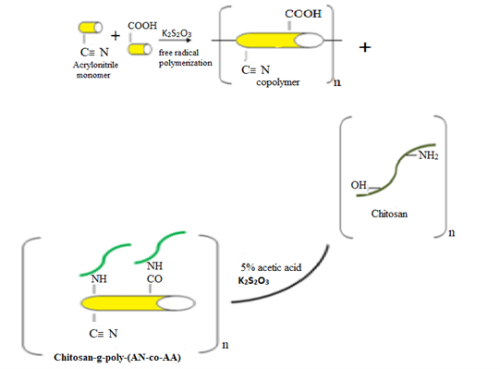
Chitosan-g-poly (acrylonitrile-co-acrylic acid) for wastewater treatment application
Abstract
Chitosan is a biodegradable natural based polymer obtained from chitin (N-deacetylated derivative), the second most abundant polysaccharide after cellulose and soluble in most organic acids. Graft copolymerization of poly (acrylonitrile-co-acrylic acid) onto chitosan has been successfully carried out using potassium persulfate as an initiator in an aqueous medium. The PAN and PAA homopolymer formed during the reaction were removed from the Chitosan grafted copolymer by Soxhlet extraction using ethanol as the solvent. The prepared graft copolymerization was characterized by Fourier transform infrared spectroscopy (FTIR), X-ray diffraction (XRD), and scanning electron microscopy (SEM) to confirm the formation of the copolymer. The prepared chitosan-g-copolymer at ratio 25:75% of AN-co-AA was treated with metal solutions containing cadmium ions, times and pH at room temperature. It[Am1] was found that the optimum condition was pH=5, Time 120min and dose of adsorbent 3 mg /L.
The results revealed that the chitosan-g-copolymer prepared was excellent in removing the heavy metals than the copolymer alone. Hence, chitosan-g- poly- AN-co-AA could open the way for wastewater treatment. The thermal stability and the electrical conductivity for all prepared samples before and after grafing were measured. By studying the thermal stability at the different ratio of AN and AA in samples co1, co2, co3, it was found that the most thermal stability sample ratio is co3 due to increasing the ratio of AN. While in sample co1 with a high ratio of AA, the thermal stability decrease according to the fast decomposition of –COOH of acrylic acid. The conductivity was 3.85x10-7 which is more than the copolymer without chitosan, which increases the electron density of the copolymer through the end group effect. As the result of σ has a range 10-8 S/cm-1 10-6 S/cm-1so, all the prepared sample can be used as an electrostatic dissipation application.
Full Text:
PDFReferences
- A. Pal, D. Das, A.K. Sarkar, S. Ghorai, R. Das, and
S. Pal, Synthesis of glycogen and poly (acrylic acid)-based graft copolymers via ATRP and its application for selective removal of Pb2+ ions from aqueous solution, Eur. Polym. J., 2015, 66, 33–46.
- H. Ren, Z. Gao, D. Wu, J. Jiang, Y. Sun, and C. Luo, Efficient Pb (II) removal using sodium alginate–carboxymethyl cellulose gel beads: Preparation, characterization, and adsorption mechanism, Carbohydr. Polym., 2016, 137, 402–409.
- M. Vakili, M. Rafatullah, B. Salamatinia, A.Z. Abdullah, M.H. Ibrahim, K.B. Tan, Z. Gholamic, P. Amouzgar, Application of chitosan and its derivatives as adsorbents for dye removal from water and wastewater, Carbohyd Polym., 2014, 113, 115-130.
- J. Dai, H. Yan, H. Yang, and R. Cheng, Simple method for preparation of chitosan/poly (acrylic acid) blending hydrogel beads and adsorption of copper (II) from aqueous solutions, Chem. Eng. J., 2010, 165(1), 240–249.
- M. Vakili, M. Rafatullah, B. Salamatinia, M.H. Ibrahim, A.Z. Abdullah, Elimination of reactive blue 4 from aqueous solutions using 3-aminopropyl triethoxysilane modified chitosan beads, Carbohydrate Polymers, 2015, 132, 89–96.
- M. Vakili, M. Rafatullah, M.H. Ibrahim, A.Z. Abdullah, B. Salamatinia, Z. Gholami, Chitosan Hydrogel Beads Impregnated with Hexadecylamine for Improved Reactive Blue 4 Adsorption, Carbohydrate Polymer, 2016, 137, 139-146.
- Y. Lin, Y. Hong, Q. Song, Z. Zhang, J. Gao, and
T. Tao, Highly efficient removal of copper ions from water using poly (acrylic acid)-grafted chitosan adsorbent, Colloid Polym. Sci., 2017, 295(4), 627–635.
- Z.A. Sutirman, M.M. Sanagi, and A.A.B.U. NAIM, Ammonium Persulfate-initiated Graft Copolymerization of Methacrylamide onto Chitosan: Synthesis, Characterization and Optimization, Sains Malaysiana, 2017, 46(12), 2433–2440.
- A. Shanmugapriya, R. Ramya, S. Ramasubramaniam, and P.N. Sudha, Studies on the removal of Cr (VI) and Cu (II) ions using chitosan grafted-polyacrylonitrile, Arch. Appl. Sci. Res., 2011, 3(3), 424–435.
- S.G. Mohammad, S.M. Ahmed, A.F.M. Badawi, and D.S. El-Desouki, Activated carbon derived from Egyptian banana peels for removal of cadmium from water, J. Appl. Life Sci. Int., 2015, 3(2), 77–88.
- N. Prakash, P.N. Sudha, and N.G. Renganathan, Copper and cadmium removal from synthetic industrial wastewater using chitosan and nylon 6, Environ. Sci. Pollut. Res., 2012, 19(7), 2930–2941.
- M.A. El-Fattah, A.M. El Saeed, A.M. Azzam, A.R.M. Abdul-Raheim, and H.H.H. Hefni, Improvement of corrosion resistance, antimicrobial activity, mechanical and chemical properties of epoxy coating by loading chitosan as a natural renewable resource, Prog. Org. Coatings, 2016, 101, 288–296.
- E. Ismar and A.S. Sarac, Synthesis and characterization of poly (acrylonitrile-co-acrylic acid) as a precursor of carbon nanofibers, Polym. Adv. Technol., 2016, 27(10),1383–1388.
- N.S.M. Rapeia, S.A.M. Jamil, L.C. Abdullah, M.N. Mobarekeh, T.C.S. Yaw, S.J. Huey, N.A. M. Zahri, Preparation and characterization of hydrazine-modified poly (acrylonitrile-co-acrylic acid), J. Eng. Sci. Technol., 2015, 4(1), 61–70.
- E. Guibal, Interactions of metal ions with chitosan-based sorbents: a review, Sep. Purif. Technol., 2004, 38 ,43–74.
- R.S. Acharyulu, T. Gomathi, P.N. Sudha, Physico-chemical characterization of cross-linked chitosan-polyacrylonitrile polymer blends. Der Pharmacia Lettre, 2013, 5(2), 354-363.
- D. Kumar, J. Pandey, and P. Kumar, Synthesis and characterization of modified chitosan via microwave route for novel antibacterial application, Int. J. Biol. Macromol., 2018, 107, 1388–1394.
- S. M. Ahmed, F.I. El-Dib, N.S. El-Gendy, W.M. Sayed, and M. El-Khodary, A kinetic study for the removal of anionic sulfonated dye from aqueous solution using nano-polyaniline and Baker’s yeast, Arab. J. Chem., 2016, 9, S1721–S1728.
- E.P. Kuncoro, J. Roussy, E. Guibal, Mercury recovery by polymer-enhanced ultrafiltration: comparison of chitosan and poly(ethylenimine) used as macroligand, Sep. Sci. Technol., 2005, 40,
–684.
- A. Ahmad, K.B.M. Isa, and Z. Osman, Conductivity and structural studies of plasticized polyacrylonitrile (PAN)-lithium triflate polymer electrolyte films, Sains Malaysiana, 2011, 40(7), 691–694.
- J.B. Marroquin, K.Y. Rhee, and S.J. Park, Chitosan nanocomposite films: enhanced electrical conductivity, thermal stability, and mechanical properties, Carbohydr. Polym., 2013, 92(2), 1783–1791.
- E.M. Sadek, D.E. El-Nashar, A.A. Ward, and S.M. Ahmed, Study on the properties of multi-walled carbon nanotubes reinforced poly (vinyl alcohol) composites, J. Polym. Res., 2018, 25(12), 249.
DOI: http://dx.doi.org/10.13171/mjc9602001061110am
Refbacks
- There are currently no refbacks.
Copyright (c) 2020 Mediterranean Journal of Chemistry
